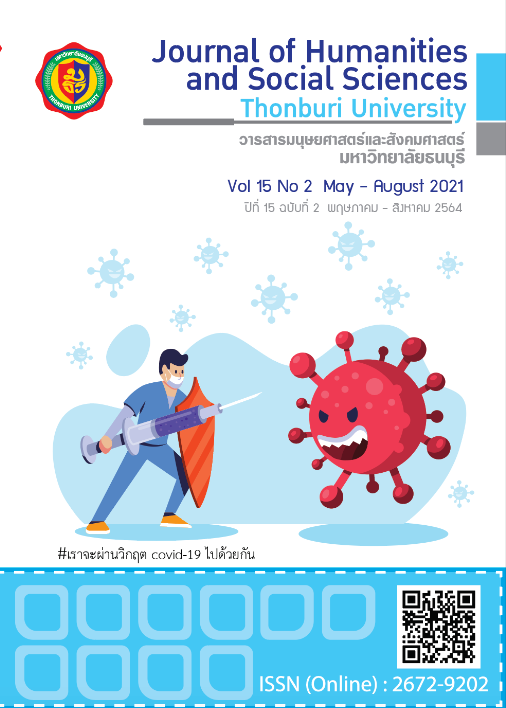Economic Assimilation in The Second Generation of Myanmar Migrant Workers in Samutsakhon Province, Thailand
Keywords:
Economic Assimilation, Assimilation, Second generation, Myanmar migrantAbstract
The paper investigates factors influencing the level of Economic Assimilation in the second generation of Myanmar migrant workers in Samutsakhon Province.The study was conducted quantitatively within individual-level analysis unit. Multi-stage random sampling technique and collected from February to March 2020 through scheduled interviews. The data were analyzed by descriptive statistics and multiple regression analyses, From demographic information, 52.4% were female. The average age was 23 years and 3 in every 5 were graduated junior high school in Thailand. Most of them are unemployed and have knowledge about work rights s at a relatively high level as 66.3% and 81.3% socialization like Thai society, 79.8% of these migrant workers have social relations at a relatively high and higher levels, 38.4% have a high level of perceiving information about their work from different types of media, 78.4% have a high level Thai naturalization knowledge and had a relatively high level of economic integration and 83.7 %. The result also found 3 factors influenced economic assimilation with statistical significance at the level of 0.05, there are the knowledge about work rights, social relations, including the knowledge about Thai naturalization. All of the variables could explain the Economic Assimilation by 17.0% (R2 = 0.170)
References
ขวัญชีวัน บัวแดง. (2554). การปรับตัวทางสังคมและวัฒนธรรมของทายาทรุ่นที่ 2 ของผู้ย้ายถิ่นจากประเทศพม่า. กรุงเทพฯ: สำนักงานกองทุนสนับสนุนการวิจัย.
เฉลิมพล แจ่มจันทร์; และ กัญญา อภิพรชัยสกุล. (2562). เด็กข้ามชาติ เกิด อยู่ โต อย่างไร. นครปฐม: สถาบันวิจัยประชากรและสังคม มหาวิทยาลัยมหิดล.
ปรีดา นัคเร และยุบล เบ็ญจรงค์กิจ. (2561). การสื่อสารระหว่างวัฒนธรรมในการจ้างแรงงานชาวเมียนม่าร์ในพื้นที่ภาคใต้ของประเทศไทย. วิชาการมนุษยศาสตร์และสังคมศาสตร์, 26 (52): 166-187.
สำนักงานจัดหางาน จังหวัดสมุทรสาคร. (2556). ชุมชนที่มีแรงงานต่างด้าวในจังหวัดสมุทรสาคร. สมุทรสาคร: สำนักงานจัดหางาน จังหวัดสมุทรสาคร.
สำนักงานจัดหางาน จังหวัดสมุทรสาคร. (2562). จำนวนแรงงานข้ามชาติชาวเมียนมาอายุระหว่าง 18 – 28 ปี ที่ได้รับจ้างทำงานในจังหวัดสมุทรสาคร. สมุทรสาคร : สำนักงานจัดหางานจังหวัดสมุทรสาคร.
สำนักบริหารแรงงานต่างด้าว. (2522). การกำหนดในอาชีพและวิชาชีพที่ห้ามคนต่างด้าวทำ พ.ศ. 2522. สืบค้นเมื่อ 15 เมษายน 2563, จาก from http://www.mol.go.th/en/node/3949
อดิศร เกิดมงคล. (2557). แรงงานข้ามชาติในสังคมไทย : สิทธิและสวัสดิการ. เชียงใหม่: ศูนย์อาเซียนศึกษา มหาวิทยาลัยเชียงใหม่.
Billingham M. (2007). Sociological perspectives. In: Stretch B and Whitehouse M (eds) Health and social care. Oxford, UK: Heinemann, 301-334.
Cochran, W. G. (1977). Sampling Techniques, 3rd Edition. Oxford, England: John Wiley.
Collins, W., & Zimran, A. (2019). The economic assimilation of Irish Famine migrants to the United States. Explorations in Economic History, 74(1): 215-224.
Hauck, K, Hollingsworth, B. and Morgan, L. (2012). BMI differences in 1st and 2nd generation immigrants of Asian and European origin to Australia. Health Place, 17(1), 78-85.
Ismail, S. M. (2016). Demystifying the Belittled Second Generation of Human Rights. Retrieved April 20, 2020, from http://1ab.in/nMv
Margaret, M.C. (2016). Navigating the road to work: second generation Asian American finance workers. Asian American policy review, 26(1), 20-29.
Portes, A., & Zhou, M. (1993). The New Second Generation: Segmented Assimilation and Its Variants. The Annals of the American Academy of Political and Social Science, 530(1): 74-96.
Save the Children in Thailand. (2015). The path to a better future Educational criticism For multinational children in Thailand. World Education.
Serhan, R. (2015). Palestinian American National Research Project. Washington, D.C: The General Delegation of the PLO to the United States.
The Asia Foundation and International Labour Organization. (2015). Migrant and Child Labor in Thailand’s Shrimp and Other Seafood Supply Chains: Labor Conditions and the Decision to Study or Work. Bangkok, Thailand.
Un-ob, P. (2016). Research Design: Map of research destination. Retrieved June 5, 2020, from http://rlc.nrct.go. th/ewt_dl.php?nid=768
Vigdor, J.L. (2013). Measuring Immigrant Assimilation in Post-Recession America. Civic Report. Retrieved January 15, 2020, from https://www.manhattan-institute.org/html/measuring-immigrant-assimilation-post-recession-america-5858.html
Translated Thai References
Bawdaeng, K. (2011). Social and cultural adaptation of generation 2 heirs of migrants from Myanmar. Bangkok: The Thailand Research Fund. (in Thai)
Chamchan, C., & Apipornchaisakul, K. (2019). Migrant Children: How was it born?. Nakorn Patom: Institute for Population and Social Research, Mahidol University. (in Thai)
Foreign Workers Administration Office. (1979). Assignment in professions and professions which are forbidden by aliens, B.E. 2522. Retrieved April 15, 2020, from http://www.mol.go.th/en/node/3949 (in Thai)
Keidmongkon, A. (2014). Migrant workers in Thai society: rights and welfare. Chiang Mai: Asean Studies Center Chiang Mai University. (in Thai)
Labor protection office Samut Sakhon province, (2019). Statistical data: Number of industrial factories employing migrant workers in Samut Sakhon Province. Samut Sakhon, Labor protection office Samut Sakhon province. (in Thai)
Nakre, P., & Yoonbjanarongkit (2018). Intercultural communication in hiring Myanmar workers in the southern region of Thailand. Humanities and Social Sciences, 26(52), 166-187. (in Thai)
Samut Sakhon Employment Office. (2019). Number of Myanmar migrant workers aged between 18 -28 years who have been employed in Samut Sakhon Province. Samut Sakhon, Samut Sakhon Employment Office. (in Thai)







